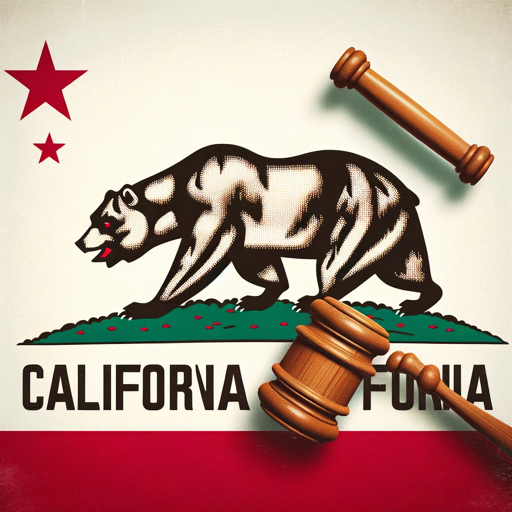Post-California Prison Planner for Success-post-prison reintegration tool with goals.
AI-powered support for personal reintegration.
How can I overcome anger and use it constructively?
What steps should I take for a successful reintegration after prison?
Can you provide strategies for building a strong support network post-prison?
How do I set realistic goals for my personal and professional growth?
Related Tools
Load More
California Law
Expert in California law for lawyers

Academic Strategy Advisor
Guiding you through doctoral courses with expertise.
USCIS-GPT
Advisor on U.S. immigration processes and services

California Family Law Guide
Expert in CA family law, referencing statutes and cases, providing citations.

California Lawyer
Expert in California Law for lawyers. Has up to date access to all California statutes spanning tenant rights, employment, taxes, and more.

Advice from Sam Altman
Advice based on Sam Altman's 17 points
20.0 / 5 (200 votes)
Introduction to Post-California Prison Planner for Success
The Post-California Prison Planner for Success is designed to guide individuals who are transitioning from the California prison system back into society. Its core purpose is to help former inmates reintegrate successfully, with a focus on personal development, mental and emotional well-being, and creating sustainable plans for life after incarceration. The program addresses key areas such as job training, education, mental health support, substance abuse counseling, and reintegration strategies. Examples of this include helping a former inmate set clear educational goals, like enrolling in a trade school, or providing emotional management tools, like anger reduction strategies. By utilizing frameworks like SMART goals, the planner tailors reintegration plans that emphasize setting Specific, Measurable, Achievable, Relevant, and Time-bound objectives, empowering former inmates to avoid 'drifting' and instead live with purpose and discipline.

Main Functions of Post-California Prison Planner for Success
SMART Goal Setting
Example
An inmate transitioning out of prison might struggle with aggression. The planner would help them create SMART goals like 'Reduce aggressive outbursts by 50% over 30 days by practicing mindfulness daily and reporting progress to a counselor.'
Scenario
In a real-world scenario, this goal might be part of an anger management program within the prison that continues into post-release life, monitored by probation officers or mental health professionals to ensure continuity.
Job Training and Education
Example
A former inmate wants to become a certified mechanic but lacks the necessary education. The planner helps them identify local trade schools, complete applications, and set measurable milestones such as 'complete 2 semesters with a B-average or higher.'
Scenario
The individual receives assistance in signing up for a local vocational training program, ensuring they have access to financial aid and are on track for employment post-graduation.
Emotional and Mental Health Support
Example
For someone prone to emotional triggers, the planner could implement tools from the 'Managing Your Triggers Toolkit' to help identify triggers and manage responses in stressful situations.
Scenario
In a work environment post-release, a former inmate might face stress and pressure. By practicing state-shifting techniques learned in the planner’s program, they manage to de-escalate emotionally charged situations, avoiding potential conflicts.
Ideal Users of Post-California Prison Planner for Success
Former Inmates Transitioning from California Prisons
These are individuals who have served time in California prisons and are re-entering society. They benefit most from the planner’s structured approach, which helps them navigate emotional, financial, and social challenges. The planner helps them address the psychological impact of incarceration, such as emotional regulation and skill development, crucial for their reintegration.
Mental Health and Substance Abuse Rehabilitation Candidates
Inmates dealing with mental health issues or substance abuse history are another key group. The planner offers customized substance abuse counseling and recovery-focused tools, like engaging with 12-step programs or working on emotional sobriety goals, providing structure for recovery and successful reintegration into the community.

Guidelines for Using Post-California Prison Planner for Success
Visit aichatonline.org for a free trial without login, also no need for ChatGPT Plus.
The first step is to visit the website and access the free trial service, which does not require signing up or having a premium account like ChatGPT Plus. This makes it accessible and easy to start using.
Explore Resources on Reintegration.
Once logged in, navigate through various modules focusing on personal development, mental health, education, job training, and goal-setting. These resources are tailored to help individuals transitioning out of prison.
Set Personalized SMART Goals.
Use the tool to set Specific, Measurable, Achievable, Relevant, and Time-bound (SMART) goals aimed at improving anger management, communication, and emotional control, aligning with a reintegration plan.
Leverage Community Support.
The planner provides access to community forums, peer support, and counseling services to ensure that you are not working in isolation. Interact with others who are on a similar journey to exchange insights and support.
Track Progress and Review.
Utilize progress tracking features that allow you to log your achievements, challenges, and adjustments to goals over time. Set up regular reviews with mentors or counselors to evaluate and adapt your reintegration plan.
Try other advanced and practical GPTs
Valiantskillz's Ultimate How-To / LUA coding AI
AI-powered tutor for Roblox & Lua mastery

GrowBot
AI-Powered Plant Cultivation Support

Car Community
AI-powered car knowledge hub.

Laravel TALL Stack
AI-powered web development using Laravel TALL

Geo's Tall Stack (Filament 3, Livewire 3) GPT
AI-Powered TALL Stack Development Support

Learn Medicin
AI-driven learning for medical students.

Power System AI
AI-Powered Solutions for Power Systems

英汉智能互译 Chinese-English Mutual Translation
AI-powered Chinese-English translation tool.
Replace Anything
AI-powered transformations for images and text.

EU AI Act Assistant
AI-powered assistant for AI regulation clarity.

Animated Logo Creator
AI-powered dynamic logo creation.

Construction Contracts Law AI Advisor
AI-Powered Insights for Construction Contracts

- Goal Setting
- Emotional Health
- Anger Control
- Reintegration
- Career Skills
Frequently Asked Questions About Post-California Prison Planner for Success
What is the main purpose of the Post-California Prison Planner?
The tool helps individuals reintegrate into society after imprisonment by focusing on personal development, goal-setting, emotional intelligence, and building support networks. It provides structured plans and resources for sustainable success.
Can I use this tool without any professional guidance?
Yes, the platform is designed to be self-guided, though it also offers options to involve mentors, counselors, and support communities for additional guidance.
What types of goals can I set with the planner?
You can set various goals focusing on mental health, anger management, addiction recovery, education, employment skills, and emotional intelligence. All goals follow the SMART framework for effective tracking and completion.
Is the planner tailored for individuals with unique psychological needs?
Yes, it offers specialized resources for individuals facing psychological challenges such as PTSD, depression, or anxiety. These resources help in managing emotions and improving coping mechanisms during reintegration.
How is progress tracked and evaluated?
The tool allows users to log their daily activities, goal progression, and emotional states. Progress is reviewed periodically with the option to adjust goals based on challenges or achievements.